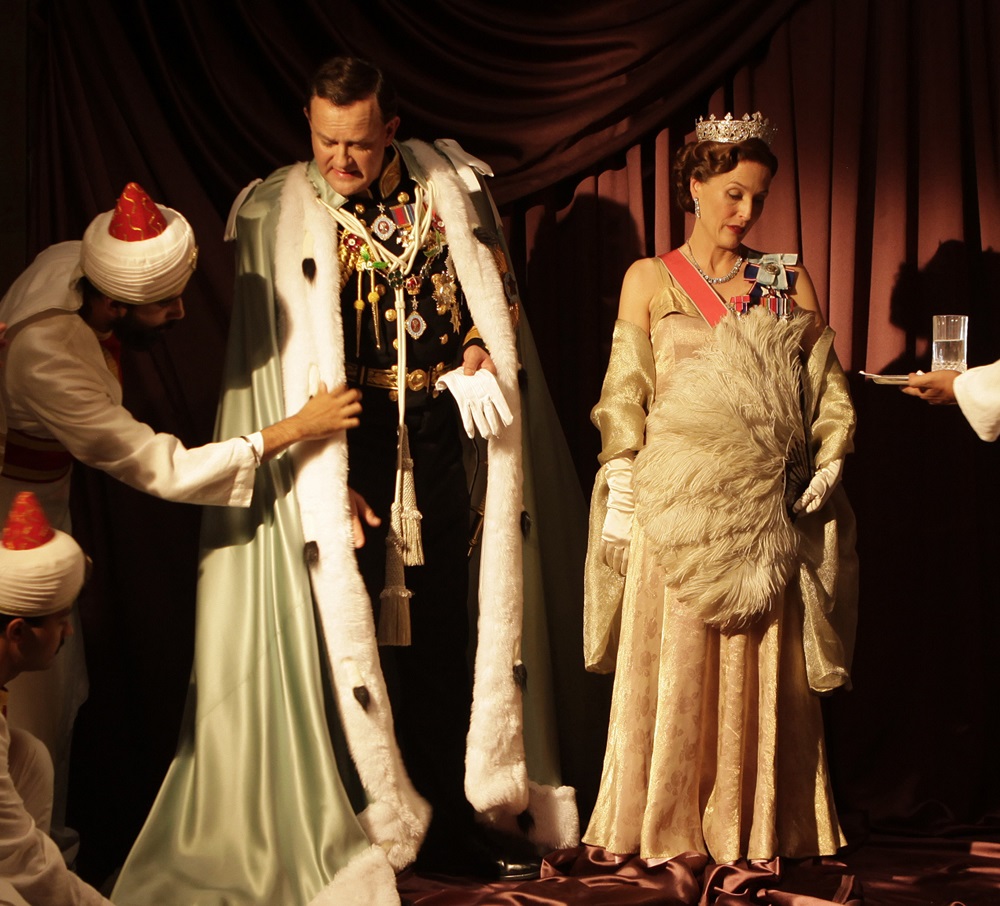Viceroy's House | reviews, news & interviews
Viceroy's House
Viceroy's House
Gurinder Chadha's take on India's Partition should have been a 10-parter on Netflix
The Partition of India is vast and unexplored terrain in modern cinema. It triggered the migration of 14 million people: Muslims moved from an India reduced in size overnight to the new homeland of Pakistan, and non-Muslims made the opposite journey. It was what we’ve seen in Syria but multiplied by sheer volume of numbers, and squeezed into a much smaller timeframe. The border squiggled on the map was arbitrary and conjured up in haste. So a film about this seismic subcontinental shift is long overdue. It has fallen to Gurinder Chadha, a British filmmaker of Indian origin brought up in Kenya, to try to squeeze a huge canvas onto the screen.
Rather than fan out across India in the manner of David Lean’s A Passage to India or Richard Attenborough’s Gandhi, Viceroy’s House confines itself of the official residence of the man who oversaw the transition to independence in 1947. Lord Louis Mountbatten – Dickie to his wife Edwina and other assorted intimates – assumes the genial form of Hugh Bonneville, who has had quite a lot of practice at being nice to the servants as they dress him up in silly outfits. His thankless task is to oversee discussions among the leading figures in India’s political landscape - Nehru, Jinnah and Gandhi. Meanwhile his own cohort of governors report trouble in the regions, internecine massacres which the departing British no longer have the manpower to prevent. For budgetary reasons these larger events happen off camera or in newsreels, but the house itself is not cut off from the wider context. The liveried servants, the staff in the kitchen, the guards all have an urgent need to know what’s happening in the negotiations. Some yearn for an independent Muslim state, others are passionate for India to remain whole. Thus there’s a good deal of listening at keyholes and through cracks in doors.Chadha’s script, written with Paul Mayeda Berges, dramatises a nation’s agony in a story of thwarted love between two members of staff. Jeet Kumar, who is Hindu, falls for Aalia (Manish Dayal and Huma Qureshi, pictured above), the daughter of a former Muslim political prisoner (Om Puri). The problem is that Aalia is betrothed to one of her own, a soldier who hasn’t returned from the war. In the palace compound where they live tensions rise between communities, until the Muslim housing is torched.
For budgetary reasons these larger events happen off camera or in newsreels, but the house itself is not cut off from the wider context. The liveried servants, the staff in the kitchen, the guards all have an urgent need to know what’s happening in the negotiations. Some yearn for an independent Muslim state, others are passionate for India to remain whole. Thus there’s a good deal of listening at keyholes and through cracks in doors.Chadha’s script, written with Paul Mayeda Berges, dramatises a nation’s agony in a story of thwarted love between two members of staff. Jeet Kumar, who is Hindu, falls for Aalia (Manish Dayal and Huma Qureshi, pictured above), the daughter of a former Muslim political prisoner (Om Puri). The problem is that Aalia is betrothed to one of her own, a soldier who hasn’t returned from the war. In the palace compound where they live tensions rise between communities, until the Muslim housing is torched.
 The film is very handsome to look at, and Chadha’s funny bones lay on plenty of light entertainment. But the laughs – and the sumptuous production values - feel like a sleight of hand distracting from the greater tragedy of India’s unseen agonies, which are mainly reported in dialogue between the higher-ups. Britain also gets a bit of a free pass as the architect of Partition. It falls to Michael Gambon as General Hastings Lionel Ismay, 1st Baron Ismay, KG, GCB, CH, DSO, PC, DL - "Pug" to his chums - to embody the nastier side of British realpolitik, while the Mountbatten family unit – and by implication the British establishment as a whole – is portrayed in the most flattering light.
The film is very handsome to look at, and Chadha’s funny bones lay on plenty of light entertainment. But the laughs – and the sumptuous production values - feel like a sleight of hand distracting from the greater tragedy of India’s unseen agonies, which are mainly reported in dialogue between the higher-ups. Britain also gets a bit of a free pass as the architect of Partition. It falls to Michael Gambon as General Hastings Lionel Ismay, 1st Baron Ismay, KG, GCB, CH, DSO, PC, DL - "Pug" to his chums - to embody the nastier side of British realpolitik, while the Mountbatten family unit – and by implication the British establishment as a whole – is portrayed in the most flattering light.
Because Mountbatten had only six weeks to deliver independence, there’s an artistic justification to the corresponding compression of a huge story into less than two hours. It does feel overcrowded and each narrative feels as if it would profit by expansion. In another world, and with a bigger budget, this would be a simmering 10-parter on Netflix, in which the nuances and niceties and, damn it, the political complexities might be given more air to breathe. As it is, Viceroy’s House takes its storytelling cue from Gillian Anderson’s decision to squeeze Edwina Mountbatten’s vowels into a tight space.
'I've never set foot in India in my life': watch a clip from Viceroy's House
Add comment
more Film
 The Book of Clarence review - larky jaunt through biblical epic territory
LaKeith Stanfield is impressively watchable as the Messiah's near-neighbour
The Book of Clarence review - larky jaunt through biblical epic territory
LaKeith Stanfield is impressively watchable as the Messiah's near-neighbour
 Blu-ray/DVD: Priscilla
The disc extras smartly contextualise Sofia Coppola's eighth feature
Blu-ray/DVD: Priscilla
The disc extras smartly contextualise Sofia Coppola's eighth feature
 Back to Black review - rock biopic with a loving but soft touch
Marisa Abela evokes the genius of Amy Winehouse, with a few warts minimised
Back to Black review - rock biopic with a loving but soft touch
Marisa Abela evokes the genius of Amy Winehouse, with a few warts minimised
 Civil War review - God help America
A horrifying State of the Union address from Alex Garland
Civil War review - God help America
A horrifying State of the Union address from Alex Garland
 The Teachers' Lounge - teacher-pupil relationships under the microscope
Thoughtful, painful meditation on status, crime, and power
The Teachers' Lounge - teacher-pupil relationships under the microscope
Thoughtful, painful meditation on status, crime, and power
 Blu-ray: Happy End (Šťastný konec)
Technically brilliant black comedy hasn't aged well
Blu-ray: Happy End (Šťastný konec)
Technically brilliant black comedy hasn't aged well
 Evil Does Not Exist review - Ryusuke Hamaguchi's nuanced follow-up to 'Drive My Car'
A parable about the perils of eco-tourism with a violent twist
Evil Does Not Exist review - Ryusuke Hamaguchi's nuanced follow-up to 'Drive My Car'
A parable about the perils of eco-tourism with a violent twist
 Io Capitano review - gripping odyssey from Senegal to Italy
Matteo Garrone's Oscar-nominated drama of two teenage boys pursuing their dream
Io Capitano review - gripping odyssey from Senegal to Italy
Matteo Garrone's Oscar-nominated drama of two teenage boys pursuing their dream
 The Trouble with Jessica review - the London housing market wreaks havoc on a group of friends
Matt Winn directs a glossy cast in a black comedy that verges on farce
The Trouble with Jessica review - the London housing market wreaks havoc on a group of friends
Matt Winn directs a glossy cast in a black comedy that verges on farce
 Silver Haze review - daughters of Albion dealing with damage
Vicky Knight and Esmé Creed-Miles shine in a drama inspired by Knight's tragic past
Silver Haze review - daughters of Albion dealing with damage
Vicky Knight and Esmé Creed-Miles shine in a drama inspired by Knight's tragic past
 Mothers' Instinct review - 'Mad Women'
Sixties suburban duel veers between daftness and spooky power
Mothers' Instinct review - 'Mad Women'
Sixties suburban duel veers between daftness and spooky power
 Godzilla x Kong: The New Empire review - a bit of a monster let-down
Old foes become new friends amid the usual wreckage
Godzilla x Kong: The New Empire review - a bit of a monster let-down
Old foes become new friends amid the usual wreckage

Comments
felt that Hugh Bonneville was